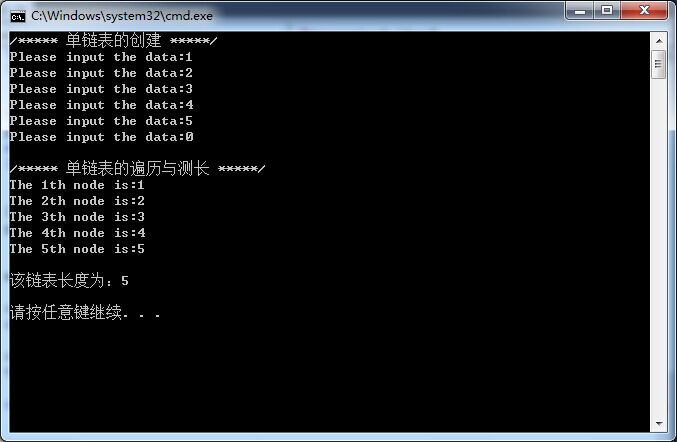示例代码如下:
#include<iostream>
using namespace std;
///单链表结构体:结点
typedef struct student
{
int data; //结点中的数据
struct student *next; //指向链表下一个结点的指针
}node;
node *head; //头结点指针
///建立单链表
void *create()
{
node *p,*s; //增加结点的位置指针、要增加结点的指针
int x,cycle=1; //x是结点中的数据,若为0代表创建结束;cycle是循环控制变量
head=(node*)malloc(sizeof(node)); //动态分配,建立头节点
p=head;
while(cycle)
{
printf("Please input the data:");
scanf("%d",&x);
if(x!=0)
{
s=(node*)malloc(sizeof(node)); //动态分配,每次新建一个节点
s->data=x; //将数据存入该结点
// printf("%d\n",s->data); //查看该结点中的数据是否正确
p->next=s; //连接头指针与当前结点
p=s; //并将头指针指向当前结点的指针,即下一个结点的地址
}
else
{
cycle=0;
}
}
p->next=NULL; //最后一个结点为空指针(必须)
// head=head->next; //创建完毕单链表,头结点指针回去
// printf("\n yyy %d",head->data); //打印第一个结点中的数据,用于验证
return head; //返回根结点
}
///遍历单链表(单链表打印),同时测长
//注:链表无法从反方向进行遍历
void traverse(node *head)
{
node *p;
int index=0;
if(head->next==NULL)
{
printf("Link is empty!\n");
return;
}
p=head->next;
while(p!=NULL)//遍历链表
{
printf("The %dth node is:%d\n",++index,p->data);//打印元素,亦可计算链表长度(index)
p=p->next;//进入下一个结点
}
printf("\n该链表长度为:%d\n\n",index);
}
int main()
{
cout<<"/***** 单链表的创建 *****/"<<endl;
create(); //单链表的创建
cout<<endl<<"/***** 单链表的遍历与测长 *****/"<<endl;
traverse(head); //单链表的遍历与测长
return 0;
}测试结果如下图:























 1万+
1万+

 被折叠的 条评论
为什么被折叠?
被折叠的 条评论
为什么被折叠?








